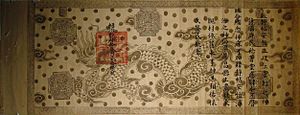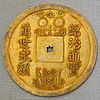Thiệu Trị facts for kids
Quick facts for kids Emperor Thiệu Trị紹治帝 |
|||||||||||||||||
|---|---|---|---|---|---|---|---|---|---|---|---|---|---|---|---|---|---|
| Emperor of Đại Nam | |||||||||||||||||
| Reign | 11 February 1841 – 4 October 1847 | ||||||||||||||||
| Predecessor | Minh Mạng | ||||||||||||||||
| Successor | Tự Đức | ||||||||||||||||
| Emperor of the Nguyễn dynasty | |||||||||||||||||
| Reign | 11 February 1841 – 4 October 1847 | ||||||||||||||||
| Predecessor | Minh Mạng | ||||||||||||||||
| Successor | Tự Đức | ||||||||||||||||
| Born | 16 June 1807 Imperial City, Huế, Việt Nam |
||||||||||||||||
| Died | 4 October 1847 (aged 40) Imperial City, Huế, Đại Nam |
||||||||||||||||
| Burial | Xương Lăng | ||||||||||||||||
| Spouse | Empress Từ Dụ more than 200 concubines |
||||||||||||||||
| Issue | 64 including 29 princes and 35 princesses, including: Nguyễn Phúc Hồng Bảo Nguyễn Phúc Hồng Nhậm Nguyễn Phúc Hồng Y Nguyễn Phúc Hồng Cai |
||||||||||||||||
|
|||||||||||||||||
| House | Nguyễn Phúc | ||||||||||||||||
| Father | Minh Mạng | ||||||||||||||||
| Mother | Empress Tá Thiên | ||||||||||||||||
| Religion | Ruism, Buddhism | ||||||||||||||||
Thiệu Trị (born Nguyễn Phúc Miên Tông or Nguyễn Phúc Tuyền) was an important emperor of Vietnam. He ruled the Nguyễn dynasty from 1841 to 1847. He was the third emperor in his family line, following his father, Emperor Minh Mạng. Thiệu Trị continued many of his father's ideas, especially keeping Vietnam separate from other countries and focusing on traditional Vietnamese culture.
Contents
Life as Emperor Thiệu Trị
Thiệu Trị was a lot like his father, Emperor Minh Mạng. He continued their family's traditional ways of ruling. This meant keeping Vietnam mostly closed off from other countries. He also strongly supported Confucianism, which is a system of beliefs and values from ancient China.
Thiệu Trị was very well-educated in Confucian traditions. He was curious about Western countries but also very careful and suspicious of anyone from outside Vietnam.
Dealing with Outsiders
At this time, countries like France and Great Britain were trying to expand their power around the world. France was especially interested in Indochina, which included Vietnam. This also meant that Christian missionaries, mostly from Spain and France, came to Vietnam. They often ignored the rules against their activities.

When Emperor Thiệu Trị started to arrest these missionaries, France reacted quickly. In 1843, the French government sent a military group to Indochina. Their goal was to protect French interests and try to free the missionaries. They hoped to do this without causing a big international problem.
Clashes with Western Ships
Thiệu Trị was determined to stop all Roman Catholic missionaries from operating in his country. This made it hard to have a peaceful relationship with France. In 1845, there was almost a fight between Vietnam and an American warship called the USS Constitution. This ship tried to make Thiệu Trị release a missionary named Dominique Lefèbvre, who had come to Vietnam many times without permission.
A French naval group arrived in Da Nang on March 23, 1847. They demanded that French citizens be safe and that Thiệu Trị stop treating missionaries badly.
The Vietnamese officials, called mandarins, delayed giving the emperor's answer. Soon, fighting broke out. Thiệu Trị had built strong defenses along the coast. However, the French forces easily won because the Nguyễn dynasty's equipment was not as good. All of Vietnam's coastal forts were destroyed, and three Vietnamese ships were sunk before the French squadron left.
After this, Thiệu Trị declared that all missionaries were enemy spies. He ordered that all Christians should be executed right away. However, the mandarins did not carry out this order. Emperor Thiệu Trị died shortly after, and no missionaries were actually executed during his time as emperor.
Emperor Thiệu Trị's Family
Emperor Thiệu Trị had a very large family, which was common for emperors at that time. He had more than 200 wives and concubines, and together they had 64 children. These included 29 princes and 35 princesses.
His most important wife was Empress Từ Dụ, also known as Phạm Thị Hằng. She was born in 1810 and lived until 1902. She was the mother of Emperor Tự Đức, who became the next emperor after Thiệu Trị. Empress Từ Dụ held many important titles throughout her long life, even after her husband and son had passed away.


